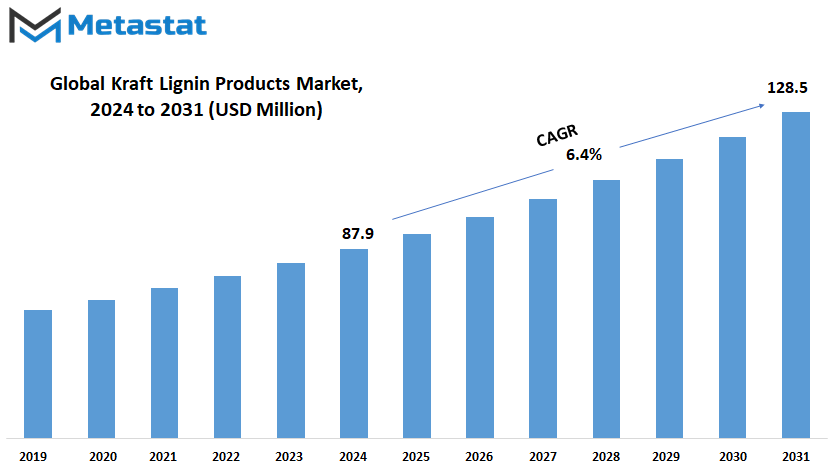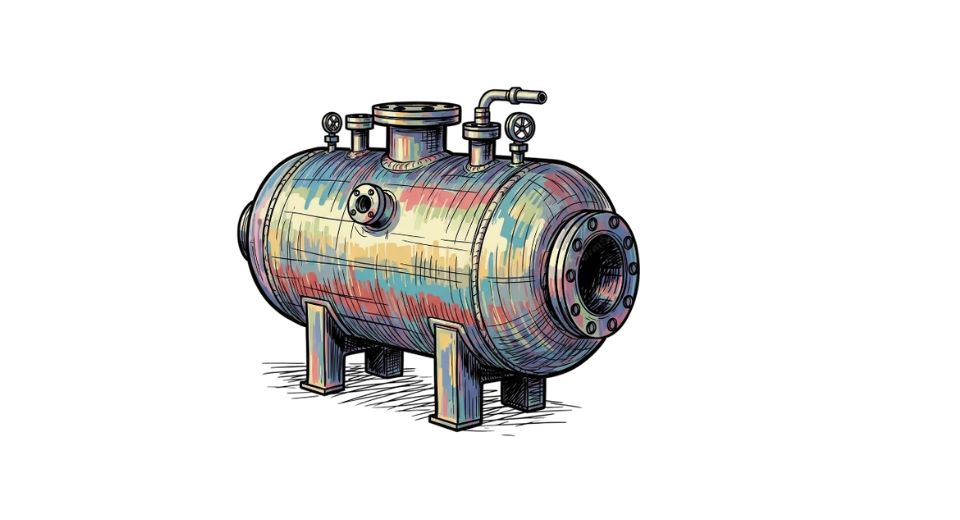MARKET OVERVIEW
The Global Kraft Lignin Products market is an important constituent part of the overall chemical industry, which has recently been gaining prominence as a separate niche with considerable potential for expansion in several directions. Traditionally, kraft lignin-a by-product of the pulping process in kraft-has been considered a low-value material mainly used as a fuel to recover energy by combustion. However, in recent years, this perception has radically changed. Kraft lignin has many varied uses, hence industries around the world study it and it is a very important resource for high-performance materials, chemicals, and even energy solutions in their manufacturing processes.
Another important factor for the Global Kraft Lignin Products market is its different industrial applications. Because of its peculiar chemical nature, lignin finds application as a feedstock for adhesives, binders, and resins. It is also used in the production of bio-based carbon fibers serving for automotive and aerospace industries in the manufacture of light yet strong components. Kraft lignin's versatility ranges into application in the agricultural sector for its function of a dispersant and emulsifier in the formulation of agrochemicals, improving its efficiency and environmental impact.
Increasing interest in sustainable and renewable resources has further stoked demand for kraft lignin products. Kraft lignin is gaining momentum as an attractive renewable feedstock alternative for industries moving towards reduced carbon footprints, as their base product has been highly reliant on inputs from petrochemicals. This trend stands to propel innovation and investment in the Global Kraft Lignin Products market. New techniques of extraction and purification of lignin are likely to continue to be developed, improving the properties and extending the application area of kraft lignin.
It is also expected that the Global Kraft Lignin Products market will have a high benefit from changes in technology and production processes. As producing methodologies continue to get refined, the quality and consistency of kraft lignin products will also improve, thereby making them more competitive with conventional materials. Nanomaterials from lignin could open completely new prospects for their applications in high-tech industries like electronics and medical equipment.
Government initiatives and regulatory support for the use of biobased materials will also continue to play an important role in the future of the Global Kraft Lignin Products market. Policymakers worldwide are embracing more stringent environmental policies and fostering sustainability practices. It is here that companies whose products include kraft lignin could realize a relative competitive advantage. This may further lead to greater collaboration between governments, research institutions, and industry players, possibly accelerating the market's growth even further.
The Global Kraft Lignin Products market, in conclusion, is a relatively new field with enormous opportunities in various verticals. Its growth may be driven in the future by an increasing demand for sustainable materials, technological progress, and enabling regulatory frameworks. Due to its value, kraft lignin use will no doubt continue diversifying into new applications, constituting the material as one of the key enablers in the transition to a greener and more sustainable future. And the market keeps changing, opening up new opportunities for innovation and investment because kraft lignin is going to be an essential feedstock within the circular bioeconomy.
Global Kraft Lignin Products market is estimated to reach $128.5 Million by 2031; growing at a CAGR of 6.4% from 2024 to 2031.

GROWTH FACTORS
The Global Kraft Lignin Products market is poised to mark outstanding growth spurred by a set of influencing factors. Among the prominent catalysts, increasing demand for green and sustainable materials is prominent. While industries strive to attain 'green' credentials, the use of lignin-a naturally occurring polymer in wood-has been particularly appealing because of its renewable and biodegradable nature. This, in turn, exerts pressure toward greener solutions and ensures better acceptance for lignin within various industries, ranging from construction to automotive and packaging.
Other factors that are giving further thrust to the growth in the market include the increasing applications of lignin in the manufacturing of bioplastics and specialty chemicals. Bioplastics, made to replace conventional plastics, are gaining momentum as their environmental footprint is lower. In this regard, the contribution by lignin is central to improving the attributes of bioplastics so that they may become more durable and capable of a variety of uses. Similarly, applications in the area of specialty chemicals, required for different types of industrial processes, have also been expanding. These not only exhibit the versatility of lignin but result in growth in the Global Kraft Lignin Products market.
However, there are some factors that can impede market dynamics: problems with lignin feedstock availability and high production costs because of its extraction from kraft pulping processes. All these factors may lead to higher prices in the market, unappealing for many buyers. Besides, competition from other materials and technologies that may show better performance or lower costs is another factor that could decelerate the market.
Consequently, despite such challenges, the improvisation of technologies in extracting and processing lignin opens up new areas of opportunity. Such improvisation is making the extraction process more feasible and enables the processing of lignin to higher value-added products. In this process, probably newer markets will be explored, and the applications would expand. The future developments of such technologies will, therefore, act as lucrative opportunities for market expansion in the years to come.
All in all, the Global Kraft Lignin Products market does bear certain constraints, but the general outlook for the market is quite positive. As demand for green materials continues to rise with new and emerging technologies and processes related to its extraction and processing, it seems that this market could be driven throughout this year. As industrial interest to go green continues unabated with advanced lignin technology, it can also see the market expand into new dimensions.
MARKET SEGMENTATION
By Type
It is estimated that the Global Kraft Lignin Products market will grow significantly as industries look towards gaining benefits from lignin in different applications. This market is defined by product diversity, wherein factors such as technological advancement and a shift in consumer preference are the determining factors.
By type, the segmentation is one of the main categories in the Global Kraft Lignin Products market. These include Softwood Kraft Lignin and Hardwood Kraft Lignin. Both types have their properties and applications, which contribute much to their popularity in respective fields.
Softwood Kraft Lignin is derived from softwood trees. This type of Kraft lignin has very good versatility and performance in its various applications. It has properties that make it an attractive raw material in a number of key sectors such as agriculture and construction. Because of the growing demand for environmental, sustainable, and eco-friendly materials, it is presumed that Softwood Kraft Lignin will see more applications in various products replacing those traditionally used that have proven less friendly to the environment. The ability to be integrated into various processes and products showcases its future potential.
The other type is Hardwood Kraft Lignin, which is derived from hardwood trees. This product has different advantages over the softwood variety. For example, Hardwood Kraft Lignin contains a higher amount of certain chemicals than softwood does, which can sometimes be helpful in industrial applications. With industries continuing to look toward finding innovative solutions and materials that achieve superior performance along with sustainability, Hardwood Kraft Lignin is bound to see greater demand. The value of this material in the market is underlined by the fact that it produces high-quality products with evolving industry standards.

By Application
The Global Kraft Lignin Products market is undergoing a paradigm shift in evolution to meet the needs of several industries. This is a market employing the use of lignin derived from wood processing; in this regard, it is increasingly acknowledged for its diverse applications. While the industries seek alternatives in sustainability and new materials, products made from Kraft lignin start to penetrate more and more markets involved in fertilizers and pesticides, polymers and plastics binders and resins, phenol and derivatives, active carbon, carbon fibers, among many others.
Kraft lignin product applications also promise several benefits regarding fertilizers and pesticides. These natural by-products are attracting interest because of their potential contribution to soil health and fertility. From the farmers' and agricultural experts' increasing awareness of environmental protection, other uses of lignin-based fertilizers and pesticides could be developed. They have a potential application in improving soil structure and nutrient availability, which is an integral component of sustainable agriculture.
It is under testing as a precursor in the preparation of polymers and plastics. Since a lot of pollution results from plastic garbage, and the environmental threat shifted public opinion against plastic products, the discovery of lignin for biodegradable or less hazardous plastics may change the face of the market. The versatility of lignin allows it to be used in various polymer formulations, thus becoming a valuable component in developing eco-friendly products.
Another area where Kraft lignin products are finding their mark is in binders and resins, key in various manufacturing processes. Lignin-based binders and resins are being studied for their potential to replace synthetic counterparts because of their enhanced sustainability and reduced environmental impact. This development could further open up new applications and innovations in industries like construction and even automobile manufacturing.
In the production of phenol and its derivatives, Kraft lignin is showing promise as a renewable resource. Phenol is a key component in many chemical processes, and using lignin as a starting material could reduce dependence on fossil fuels and lower production costs. This shift not only aligns with sustainability goals but also opens new avenues for research and development in chemical manufacturing.
Apart from that, Kraft lignin can also be used in various filtration and purification applications because it can be transformed into activated carbon. This technique will provide an eco-friendlier feedstock for producing activated carbon instead of using non-renewable feedstocks. Consequently, this lignin-based activated carbon has the potential to meet the increasing demand for green filtration solutions
Other promising applications of Kraft lignin concern carbon fibers due to their strength, considering their light weight. These carbon fibers based on lignin are able to ensure more sustainable methods of production and application, especially for aerospace and automotive industries.
This will, in turn, widen the applications of lignin products within the industrial sector, as an appreciating value of the same is perceived. In general, the Global Kraft Lignin Products market is poised to grow with a rise in industries' appreciation of lignin-based solutions. Most probably, the future of this market will be characterized by continuous research and innovation that enables further growth and application within different sectors.
|
Report Coverage |
Details |
|
Forecast Period |
2024-2031 |
|
Market Size in 2024 |
$87.9 million |
|
Market Size by 2031 |
$128.5 Million |
|
Growth Rate from 2024 to 2031 |
6.4% |
|
Base Year |
2022 |
|
Regions Covered |
North America, Europe, Asia-Pacific Green, South America, Middle East & Africa |
REGIONAL ANALYSIS
The outlook for changes is seen to come in the Kraft Lignin Products market as the business extends to major regions. Unique economic and industrial activities of each region segment the market into North America, Europe, Asia-Pacific, South America, and the Middle East & Africa.
North American region: The United States, Canada, and Mexico drive the market in this region. The US will, no doubt, accelerate huge growth within the Kraft Lignin Products sector due to an advanced technological infrastructure, coupled with a strong manufacturing base. Beyond this, Canada's emphasis on sustainable development and its resource management approaches will further drive growth in the market. Mexico, with its growing industrial segment and increasing focus on greener technologies, will play an important role in shaping regional market dynamics.
Another major segment would be Europe, which is further segmented into the UK, Germany, France, Italy, and the Rest of Europe. The UK, with its very strict environmental legislation and a concerted drive on sustainability, will also have a crucial market for Kraft Lignin Products. Germany, being highly industrial with an emphasis on eco-friendly technologies, will also be a key contributor. France and Italy also have powerful manufacturing industries, in addition to their emphasis on green innovation, which positions them as an important force for changing the market. The Rest of Europe will include other countries which are slowly building a stake in the Kraft Lignin Products market.
The Asia-Pacific will contain regions such as India, China, Japan, South Korea, and the Rest of Asia-Pacific. Rapid industrialization and economic development across the region are liable to spur market growth. Certain to be one of the major market forces will be China, with its enormous industrial base and large emphasis on sustainable development. India, too, will be adding to the momentum significantly with the growing economy and increasing emphasis on environmental sustainability. Japan and South Korea will further the growth of the market more and more with their advanced technological capabilities and strong manufacturing sectors. The Rest of Asia-Pacific will include other countries that are progressively becoming involved in the sector
The South American market for Kraft Lignin Products will witness incremental growth, which includes Brazil, Argentina, and the Rest of South America. Large industrial sectors of Brazil and the increasing focus of Argentina towards sustainability will drive this market, while the Rest of South America will develop the market with growing industrial activities.
The Middle East & Africa segment will see growth in a uniform manner. This would be further subdivided into GCC Countries, Egypt, South Africa, and Rest of Middle East & Africa. GCC Countries will have a strong impact on the market in light of its performance in the segment of economic diversification initiatives and industrial investments. Developing industrial sectors, including those in green technologies, will see Egypt and South Africa show another critical stripe. The Rest of the Middle East & Africa will include those other nations that are in gradual development in the market of Kraft Lignin Products.
All in all, each region has its particular economic and industrial characteristics which will be critical to shaping the future trajectory of the global Kraft Lignin Products market as it evolves.
COMPETITIVE PLAYERS
The market for Kraft lignin products is relatively developing with huge competition on the part of key players. It is expected that, in the next few years, the nature of this business will change due to the innovation and incorporation of new trends by the companies. The key companies shaping the future of the global Kraft lignin products market are Borregaard Lignotech, Domtar Corporation, Nippon Paper Industries Co. Ltd, Stora Enso, Suzano, UPM Biochemicals, WestRock Company, Weyerhaeuser Company, and Valmet.
Borregaard Lignotech is a rather well-established name among the participants of this market, which boasts vast experience and expertise in lignin technology. The ability to stake on research and development makes the enterprise an innovative solution provider, meeting various demands from customers. Such a focus on technological development puts it at the top of key players, largely present in the industry.
Domtar Corporation is another major contributor, providing multiple Kraft lignin products for various applications in different industries. Moving forward, the strategic market expansion and product development strategy undertaken by Domtar promises to increase its position in the global market. The company remains competitive in exploiting its wide production capacity and network of distribution.
Nippon Paper Industries Co., Ltd. also has significant contributions to the products market in Kraft lignin, with great impetus from its substantial manufacturing infrastructure along with dedicated effort towards sustainability. The various investments it has made in friendly technologies and processes showcase the company's commitment to the progress of the industry without exacerbating global environmental concerns.
With its advanced solutions and sustainability, Stora Enso is outstanding. From the basis of substantial research and development work, Stora Enso is the right company to launch new Kraft lignin products, meeting emerging needs of the markets. The main focus of the research and development also rests on sustainability and the circular economic principles that will provide the future success of the company.
With its global presence, Suzano is highly noted in production and supply on a large scale. Strategic investments by Suzano in lignin technology and the ability of Suzano to cater to diversified industrial needs are factors that will shape its position in the industry.
UPM Biochemicals is also trending upward through its focus on advanced biochemistry and sustainability. Its innovative efforts in finding new applications for Kraft lignin will probably improve its competitive position.
WestRock Company and Weyerhaeuser Company maintain substantial market participation and are among the major players within the marketplace for Kraft lignin products. These players are likely to continue holding influential positions in the industry with further technology and efficiency investments.
Last but not least, Valmet possesses a rich history in process technologies and engineering solutions, making the company vital in the Kraft lignin products market. It will be very interesting to see the further achievements of the company in the subsequent years, considering its sharp focus on innovation and efficiency.
This makes for the global Kraft lignin products market that is in constant dynamic change with key players striving for innovation and the ability to adapt to new challenges and opportunities. Together, they will create the future in this industry-driver of growth and technological advancement.
Kraft Lignin Products Market Key Segments:
By Type
- Softwood Kraft Lignin
- Hardwood Kraft Lignin
By Application
- Fertilizers & Pesticides
- Polymers/Plastics
- Binders & Resins
- Phenol & Derivatives
- Activated carbon
- Carbon fibers
- Other Applications
Key Global Kraft Lignin Products Industry Players
- Borregaard Lignotech
- Domtar Corporation
- NIPPON PAPER INDUSTRIES CO. LTD
- Stora Enso
- Suzano
- UPM Biochemicals
- WestRock Company
- Weyerhaeuser Company
- Valmet
WHAT REPORT PROVIDES
- Full in-depth analysis of the parent Industry
- Important changes in market and its dynamics
- Segmentation details of the market
- Former, on-going, and projected market analysis in terms of volume and value
- Assessment of niche industry developments
- Market share analysis
- Key strategies of major players
- Emerging segments and regional growth potential








 US: +1 3023308252
US: +1 3023308252






